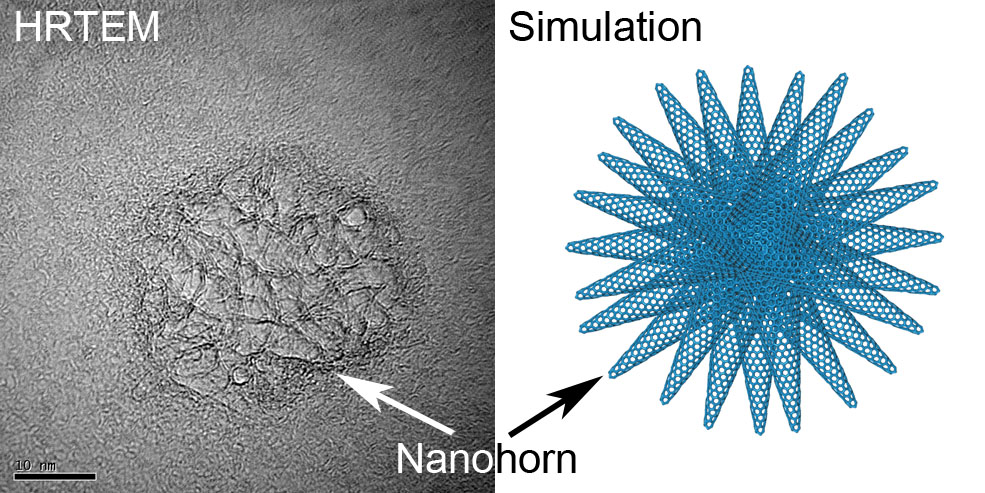Carbon Nanohorns: Unique Nanostructures for Diverse Applications
What are Carbon Nanohorns?
Carbon nanohorns (CNHs) are a unique type of carbon nanomaterial. A single CNH has a structure similar to a pudgy single-walled carbon nanotube with one end closed in a cone-shaped cap (horn). They are typically arranged in a spherical aggregate, resembling a dahlia flower. CNHs have a diameter of 2-5 nm and a length of 20-50 nm, with a conical tip at one end.

Synthesis of Carbon Nanohorns
Carbon nanohorns are typically synthesized using laser ablation or arc discharge methods. In laser ablation, a high-power laser is focused on a graphite target in an inert atmosphere, causing the vaporization and condensation of carbon into nanohorn structures. Arc discharge involves applying a high current between two graphite electrodes, resulting in the formation of carbon nanohorns in the deposit.
Properties of Carbon Nanohorns
Carbon nanohorns exhibit several unique properties that make them attractive for various applications:
- High Surface Area: CNHs have a large specific surface area, typically in the range of 1000-1500 m²/g, due to their horn-like structure and aggregate arrangement. This high surface area is beneficial for applications such as adsorption, catalysis, and energy storage.
- Excellent Adsorption Capacity: The conical structure and high surface area of CNHs enable them to effectively adsorb various molecules, including gases, organic compounds, and biomolecules. This property makes them promising for gas storage, water purification, and drug delivery applications.
- Good Electrical Conductivity: Carbon nanohorns exhibit good electrical conductivity due to their sp2 carbon network. This property, combined with their high surface area, makes them suitable for use in electrochemical sensors, supercapacitors, and fuel cells.
- Chemical and Thermal Stability: CNHs are chemically and thermally stable, withstanding high temperatures and harsh chemical environments. This stability is advantageous for applications in catalysis and high-temperature sensing.
Applications of Carbon Nanohorns
The unique properties of carbon nanohorns have led to their exploration in various fields, including:
Energy Storage
Carbon nanohorns have shown promise as electrode materials for supercapacitors and lithium-ion batteries. Their high surface area and electrical conductivity enable fast charge transfer and high energy storage capacity. CNHs can also be functionalized with metal oxides or conducting polymers to enhance their electrochemical performance.
Catalysis
The large surface area and chemical stability of carbon nanohorns make them attractive as catalyst supports. CNHs can be decorated with metal nanoparticles, such as platinum or palladium, to create highly active and stable catalysts for various chemical reactions, including fuel cell reactions and organic synthesis.
Drug Delivery
Carbon nanohorns have been explored as potential drug delivery carriers due to their ability to adsorb and release drug molecules. The conical interior of CNHs can be loaded with therapeutic agents, while the exterior surface can be functionalized with targeting ligands for specific cell or tissue delivery. The biocompatibility and low toxicity of CNHs further support their use in biomedical applications.
Environmental Remediation
The excellent adsorption capacity of carbon nanohorns can be exploited for environmental remediation purposes. CNHs can effectively remove pollutants, such as heavy metals, organic dyes, and pesticides, from water and air. Their high surface area and chemical stability make them suitable for use in water treatment and air filtration systems.
Challenges and Future Perspectives
Despite the promising potential of carbon nanohorns, several challenges need to be addressed for their widespread application. One of the main challenges is the scalable and cost-effective production of high-quality CNHs with controlled size, shape, and purity. Additionally, the long-term stability and potential toxicity of CNHs in various applications require further investigation.
Future research on carbon nanohorns will focus on the development of advanced synthesis methods, surface functionalization strategies, and the exploration of new application areas. The integration of CNHs with other nanomaterials, such as graphene and metal oxides, may lead to the creation of multifunctional nanocomposites with enhanced properties. Furthermore, the use of computational modeling and machine learning techniques will aid in the design and optimization of CNH-based materials and devices.
Further Reading
Chinese Journal of Materials Research, A Review for Synthesis and Applications of Carbon Nanohorns
